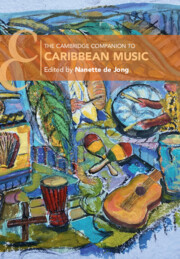Book contents
- The Cambridge Companion to Caribbean Music
- Cambridge Companions to Music
- The Cambridge Companion to Caribbean Music
- Copyright page
- Dedication
- Contents
- Figures
- Contributors
- Foreword
- Acknowledgements
- 1 Introduction to the Caribbean and Its History
- 2 Race and Transculturation
- 3 Salsa Soundings
- 4 Blackness and Identity
- 5 From the Island to Global Stages
- 6 Investigating the Caribbean’s African Past
- 7 Reframing Diasporic Belonging
- 8 Competition, Conflict, and Cooperation
- 9 Uncovering Hidden Histories of Meaning
- 10 The Foundations of Rap Music and Post-colonial Emancipation
- 11 Konpa, Zouk, and the Politics of World Music
- 12 Globalisation in the Reggae and Dub Diaspora
- 13 Musical Orality and Literacy in the Transmission of Knowledge and Praxis
- 14 Narratives of Return
- 15 Decolonising Caribbean Imaginaries
- Index
- References
11 - Konpa, Zouk, and the Politics of World Music
Haiti, Dominica, Guadeloupe, and Martinique
Published online by Cambridge University Press: 17 September 2022
- The Cambridge Companion to Caribbean Music
- Cambridge Companions to Music
- The Cambridge Companion to Caribbean Music
- Copyright page
- Dedication
- Contents
- Figures
- Contributors
- Foreword
- Acknowledgements
- 1 Introduction to the Caribbean and Its History
- 2 Race and Transculturation
- 3 Salsa Soundings
- 4 Blackness and Identity
- 5 From the Island to Global Stages
- 6 Investigating the Caribbean’s African Past
- 7 Reframing Diasporic Belonging
- 8 Competition, Conflict, and Cooperation
- 9 Uncovering Hidden Histories of Meaning
- 10 The Foundations of Rap Music and Post-colonial Emancipation
- 11 Konpa, Zouk, and the Politics of World Music
- 12 Globalisation in the Reggae and Dub Diaspora
- 13 Musical Orality and Literacy in the Transmission of Knowledge and Praxis
- 14 Narratives of Return
- 15 Decolonising Caribbean Imaginaries
- Index
- References
Summary
This chapter explores the politics of world music through an analysis of konpa and zouk. The first section provides overviews of both genres, carefully emphasising their creole beginnings. The second section focuses on how globalisation and ‘world music’ marketing have individually and collectively impacted on the two genres over the years.
- Type
- Chapter
- Information
- The Cambridge Companion to Caribbean Music , pp. 159 - 172Publisher: Cambridge University PressPrint publication year: 2022

